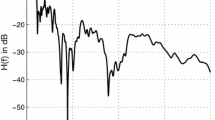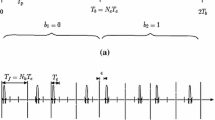Abstract
Future digital air/ground communication systems (LDACS) will operate on the L-Band where the coexistence with existing legacy systems shall be guaranteed. This paper proposes a scheme to detect and mitigate the JTIDS impulsive interference on LDACS-1 system. The novel idea advised here is the transmission of two copies of the symbols received with interference that are suitably combined at the receiver after a blanking operation of the corrupted samples. In particular two alternatives are presented that differ for the adopted retransmission policy, namely full combining scheme, where all the symbols are transmitted twice, and partial combining scheme, which foresees the retransmission of only those symbols where interference has been detected. Both these methods permit to efficiently remove the interference without affecting the useful information and exploiting profitably the diversity gain against noise through the soft combining approach. The numerical results provided in the paper highlight a good behavior of the proposed methods and significant advantages in comparison with the traditional blanking method, either in terms of Bit Error Rate and throughput.










Similar content being viewed by others
Notes
MIDS is the NATO implementation of JTIDS.
More in general we are interested in OFDM systems affected by impulsive interference.
This analysis considers the maximum values of the TSDF because they represent the worst case from an interference point of view.
OCR depends on the power spectral density of the interfering signal and on the receiver IF filter frequency response
I MAX can be usually obtained by system specifications, however at current state LDACS-1 specifications have not defined this value and we refer to the value defined for B-AMC (Broadband Aeronautical Multicarrier Communication) system from which LDACS-1 specifications have been derived.
JTIDS is a military system and many features of the system are not known.
References
ICAO (2007). Communications operating concept and requirements for the future radio system. ICAO Aeronautical Communications panel. Version 2. Montreal, May 2007.
SESAR Joint Undertaking. Available: http://www.sesarju.eu/.
Nextgen project. Available: http://www.faa.gov/nextgen/.
Bartoli, G., Fantacci, R., Marabissi, D., Micciullo, L., Fossi, M. (2013). An efficient subcarrier allocation method for AeroMACS based communication systems. IEEE Transactions on Aerospace and Electronic Systems, 49(2), 786–797.
EUROCONTROL web site. http://www.eurocontrol.int.
Budsabathon, M., & Hara, S. (2001). Robustness of OFDM signal against temporally localized impulsive noise. In Proceedings VTC 2001 fall vehicular technology conference IEEE VTS 54th, 3, 1672–1676.
Ghosh, M. (1996). Analysis of the effect of impulse noise on multicarrier and single carrier QAM systems. IEEE Transaction on communications, 44(2), 145–147.
Epple, U., & Schnell, M. (2011). Overview of interference situation and mitigation techniques for LDACS1. In Proceedings IEEE/AIAA 30th digital avionics systems conference (DASC).
Zhidkov, S.V. (2008). Analysis and comparison of several simple impulsive noise mitigation schemes for OFDM receivers. IEEE Transaction on Communications, 56(1), 5–9.
Zhidkov, S.V. (2006). Performance analysis and optimization of OFDM receiver with blanking nonlinearity in impulsive noise environment. IEEE Transaction on Vehicular Technology, 55(1), 234–242.
Yong-Hwa, K., Kyong-Hoe, K., Hui-Myoung, O., Kwan-Ho, K., Seong-Cheol, K. (2008). Mitigation of effect of impulsive noise for OFDM systems over power line channels. In Proceedings IEEE International symposium power line communications and its applications ISPLC (pp. 386–390).
Marabissi, D., Fantacci, R., Papini, S. (2006). Robust Multiuser interference cancellation for OFDM systems with frequency offset. IEEE Transaction on Wireless Communications, 5, 3068–3076.
Yih, C.-H. (2012). Iterative interference cancellation for OFDM signals with blanking nonlinearity in impulsive noise channels. IEEE Signal Processing Letter, 19(3), 147–150.
Haring, J., & Vinck, A.J.H. (2003). Iterative decoding of codes over complex numbers for impulsive noise channels. IEEE Transaction on Information Theory, 49(5), 1251–1260.
Zhidkov, S.V. (2003). Impulsive noise suppression in OFDM-based communication systems. IEEE Consumer Electronic, 49(4), 944–948.
Armstrong, J., & Suraweera, H.A. (2004). Impulse noise mitigation for OFDM using decision directed noise estimation. In IEEE international symposium spread spectrum techniques and applications (pp. 174–178).
Kitamura, T., Ohno, K., Itami, M. (2011). Iterative impulsive noise reduction by generating its replica signal in OFDM reception. In Proceedings IEEE international consumer electronics (ICCE) conference (pp. 389–390).
Al-Dweik, A., Hazmi, A., Sharif, B., Tsimenidis, C. (2010). Efficient interleaving technique for OFDM system over impulsive noise channels. In Proceedings IEEE 21st international personal indoor and mobile radio communications (PIMRC) symposium (pp. 167–171).
Ghasemi, A., & Sousa, E.S. (2008). Spectrum sensing in cognitive radio networks: requirements, challenges and design trade-offs. IEEE Communications Magazine, 32–39.
Yucek, T., & Arslan, H. (2009). A survey of spectrum sensing algorithms for cognitive radio applications. IEEE Communications Surveys and Tutorials, 11(1), 116–130.
Digham, F.F., Alouini, M.S., Simon, M.K. (2007). On the energy detection of unknown signals over fading channels. IEEE Transaction on Communications, 55(1), 21–24.
Cheng, J.-F. (2006). Coding performance of hybrid ARQ schemes. IEEE Transaction on Communications, 54(6), 1017–1029.
Fantacci, R. (1990). Performance evaluation of efficient continuous ARQ protocols. IEEE Transaction on Communications, 38(6), 773–781.
SESAR 15.2.4 ET - Task EWA04-1 T2 (2011). Updated LDACS1 system specification. Aug. 2011.
JTIDS System Segment Specification (DCB79S4000C).
European Radiocommunications Committee (ERC) within the European Conference of Postal and Telecommunications Administrations (CEPT) (2009). A comparison of the minimum coupling loss method, enhanced minimum coupling loss method, and the Monte-Carlo simulation.
ITU-R. Recommendation SM.337-4 Frequency and Distance Separations.
ITU-R. Recommendation SM.329-10 Unwanted emission in spurious domain.
Bartoli, G., Fantacci, R., Marabissi, D., Micciullo, L., Armani, C., Merlo, R. (2012). Performance evaluation of a spectrum-sensing technique for LDACS and JTIDS coexistence in L-Band. In Proceeding SDR’12—WInnComm-Europe—Wireless innovation forum announces.
Author information
Authors and Affiliations
Corresponding author
Rights and permissions
About this article
Cite this article
Bartoli, G., Fantacci, R., Marabissi, D. et al. A Novel Mitigation Scheme for JTIDS Impulsive Interference on LDACS System Based on Sensing and Symbol Retransmission. J Sign Process Syst 73, 255–266 (2013). https://doi.org/10.1007/s11265-013-0763-1
Received:
Revised:
Accepted:
Published:
Issue Date:
DOI: https://doi.org/10.1007/s11265-013-0763-1




